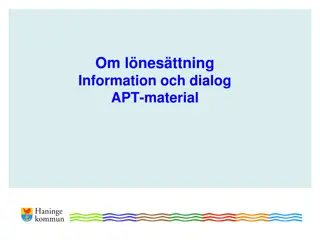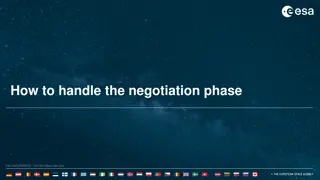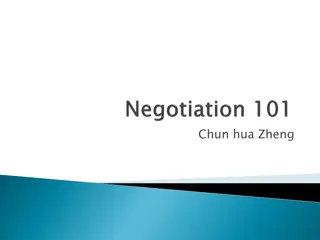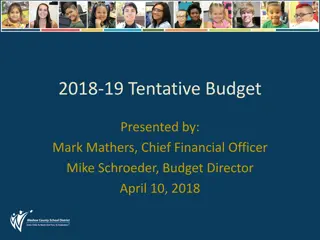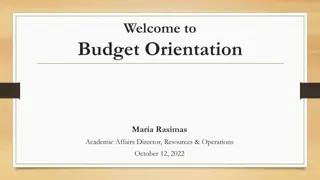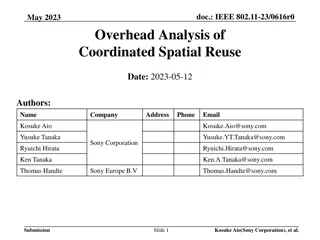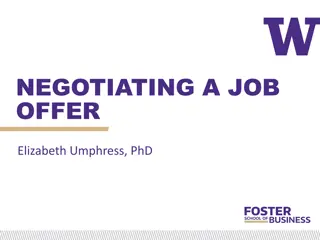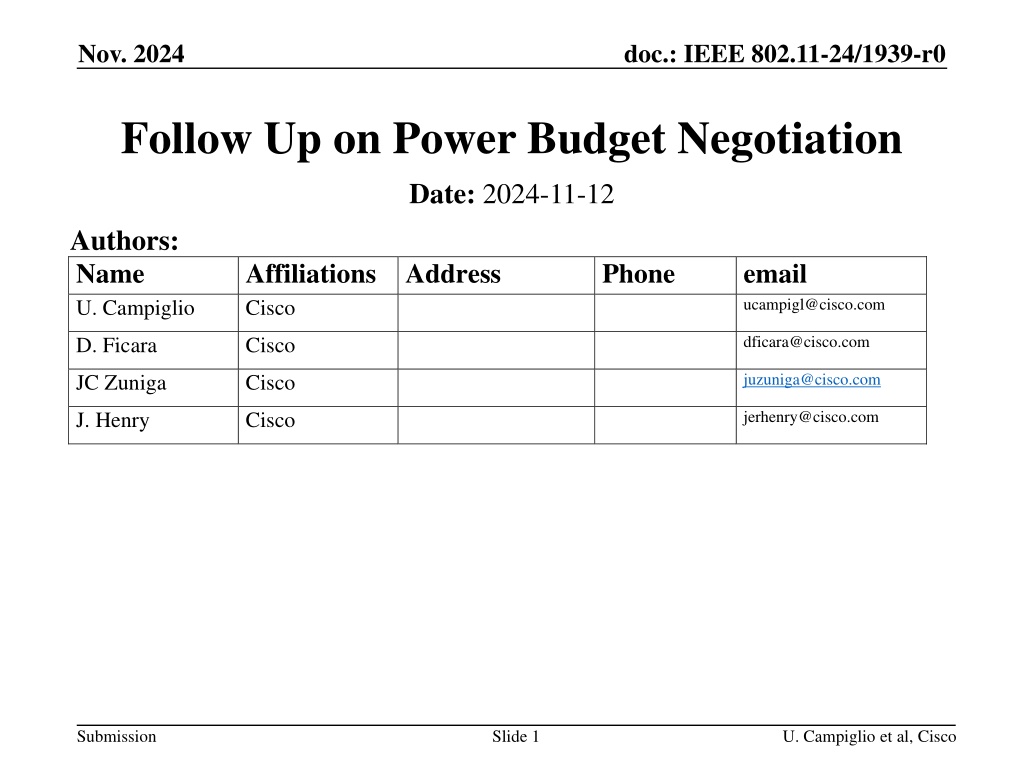
Proposal for Power Budget Negotiation in WPT Protocol
Explore a proposal to enhance the WPT protocol by incorporating power requirement and feedback information for efficient negotiation. The document delves into the need to limit the number of bits for negotiation and feedback reporting, aiming to optimize power consumption in WPT negotiations for AMP technology reliability.
Download Presentation

Please find below an Image/Link to download the presentation.
The content on the website is provided AS IS for your information and personal use only. It may not be sold, licensed, or shared on other websites without obtaining consent from the author. If you encounter any issues during the download, it is possible that the publisher has removed the file from their server.
You are allowed to download the files provided on this website for personal or commercial use, subject to the condition that they are used lawfully. All files are the property of their respective owners.
The content on the website is provided AS IS for your information and personal use only. It may not be sold, licensed, or shared on other websites without obtaining consent from the author.
E N D
Presentation Transcript
Nov. 2024 doc.: IEEE 802.11-24/1939-r0 Follow Up on Power Budget Negotiation Date: 2024-11-12 Authors: Name U. Campiglio Affiliations Address Cisco Phone email ucampigl@cisco.com dficara@cisco.com D. Ficara Cisco juzuniga@cisco.com JC Zuniga Cisco jerhenry@cisco.com J. Henry Cisco Submission Slide 1 U. Campiglio et al, Cisco
Nov. 2024 doc.: IEEE 802.11-24/1939-r0 Abstract Proposal to add power requirement and feedback information in the WPT protocol. Follow up on 11-24-1561-02-00bp limiting the number of bits required for negotiation and feedback reporting. Submission Slide 2 U. Campiglio et al, Cisco
Nov. 2024 doc.: IEEE 802.11-24/1939-r0 Background For the AMP technology to be reliable, a WPT protocol is likely needed. [1] [2] proposes STAs inform the AP about its power status [3] proposes different modes of WPT protocols [4] we proposed to exchange power related capabilities and feedback Concerns expressed on: Power consumption needed for WPT negotiation. Number of bits required to exchange WPT capabilities and feedback WPT negotiation not useful in all use cases Submission Slide 3 U. Campiglio et al, Cisco
Nov. 2024 doc.: IEEE 802.11-24/1939-r0 Motivation WPT protocol should allow: Scheduling charging frames based on AMP STAs needs Optimizing duration of charging frames WPT protocol should minimize AMP STA power consumption for negotiation Submission Slide 4 U. Campiglio et al, Cisco
Nov. 2024 doc.: IEEE 802.11-24/1939-r0 Assumptions An AMP STA has different operating modes Each mode with different power requirements The AMP STA can evaluate: its power needs (in the different modes) the energy it has harvested from one or more energizing frames (or over a period of time) An AMP AP or reader needs to provide power to multiple AMP STAs Submission Slide 5 U. Campiglio et al, Cisco
Nov. 2024 doc.: IEEE 802.11-24/1939-r0 Operating Modes Different devices can have different operating modes based on their purposes and capability. An AMP STA switches between operating modes during its operations following its own schedule. All AMP STA share an operating mode that is idle mode: AMP STA has enough energy to maintain its stateful without performing any other activity. Other examples of operating mode could be: Reading a sensor and storing the result Performing an RF transaction Etc... Submission Slide 6 U. Campiglio et al, Cisco
Nov. 2024 doc.: IEEE 802.11-24/1939-r0 Operating Mode Definition We propose to define an Operating Mode as follows: ID [0-7] Name Description Required Energy Amount Default Scheduled Frequency Submission Slide 7 U. Campiglio et al, Cisco
Nov. 2024 doc.: IEEE 802.11-24/1939-r0 Device Type Profile Made available OOB (AP accesses it on the internet) Identified by an ID shared by the AMP STA Contains: Manufacturer Name Device Description Operating Modes Energy Capacity Feedback Base Value Feedback is expressed as a percentage of this value Submission Slide 8 U. Campiglio et al, Cisco
Nov. 2024 doc.: IEEE 802.11-24/1939-r0 Device Type Profile ID Proposal A: value is assigned by external organization (IANA, Wi-Fi Alliance, other) could be for example 32-bit unique identifier Proposal B: Device Type Profile is a compressed URL where the AP can retrieve the profile (inspired by MUD RFC8520) Submission Slide 9 U. Campiglio et al, Cisco
Nov. 2024 doc.: IEEE 802.11-24/1939-r0 WPT Budget and Feedback Reporting WPT initial negotiation can happen during discovery The AMP device only gives the Device Type Profile ID (32 bits) WPT feedback: Harvested energy (7 bits) Current Battery Level (7 bits) Possible Scheduled Frequency Change (17 bits) AP uses this information: to calculate the charging frame duration to schedule charging of several AMP STAs Submission Slide 10 U. Campiglio et al, Cisco
Nov. 2024 doc.: IEEE 802.11-24/1939-r0 WPT Budget Reporting Example AP AMP STA 1 AMP STA 2 Charging frame AP transmit at x dBm for y s Poll for new AMP STAs Poll response from AMP STA1: - Energy harvested from charging frame (%) - Battery level (%) - AMP Device Profile ID Poll response from AMP STA2: - Energy harvested from charging frame (%) - Battery level (%) - AMP Device Profile ID Submission Slide 11 U. Campiglio et al, Cisco
Nov. 2024 doc.: IEEE 802.11-24/1939-r0 WPT Feedback Reporting Example AP AMP STA 1 AMP STA 2 Charging frame AP transmit at x dBm for y s Poll for AMP STAs data from AMP STA1 and AMP STA2 Poll response from AMP1 STA: - Energy harvested from charging frame (optional) - Battery level (optional) - Operating Mode Frequency Change (optional) - Data Poll response from AMP STA2: - Energy harvested from charging frame (optional) - Battery level (optional) - Operating Mode Frequency Change (optional) - Data Submission Slide 12 U. Campiglio et al, Cisco
Nov. 2024 doc.: IEEE 802.11-24/1939-r0 Operational Mode Frequency Change The known device needs to exchange: Operational mode ID: 8 bits New Frequency: 17 bits [hours (5 bits), minutes (6 bits), seconds (6 bits)] Submission Slide 13 U. Campiglio et al, Cisco
Nov. 2024 doc.: IEEE 802.11-24/1939-r0 Summary We suggest creating a WPT negotiation protocol for the AMP STA to share its power needs (amount and frequency) and the currently harvested energy with the AP. AP can avoid sending too long charging frame if no need (except for discovery). AP can schedule charging frames dynamically. Example of such WPT protocol (to be discussed) with minimal number of bits used. Submission Slide 14 U. Campiglio et al, Cisco
Nov. 2024 doc.: IEEE 802.11-24/1939-r0 Discussion and Feedback Submission Slide 15 U. Campiglio et al, Cisco
Nov. 2024 doc.: IEEE 802.11-24/1939-r0 Straw Poll 1 Do you agree to include in the WPT protocol an optional mechanism for the AMP STA to inform the AP about its power requirements ? Yes No Abstain Submission Slide 16 U. Campiglio et al, Cisco
Nov. 2024 doc.: IEEE 802.11-24/1939-r0 Straw Poll 2 Do you agree to include in the WPT protocol an optional mechanism for the AMP STA to give feedback on harvested energy, for example, from a charging frame or over a period of time? Yes No Abstain Submission Slide 17 U. Campiglio et al, Cisco
Nov. 2024 doc.: IEEE 802.11-24/1939-r0 References [1] 11-24-0575-01-0amp-p802-11bp-par.pdf [2] 11-24-1381-00-00bp-amp-device-power-status [3] 11-24-1208-00-00bp-thoughts-on-the-amp-wpt- protocol [4] 11-24-1561-02-00amp-power-budget-negotiation.ppt Submission Slide 18 U. Campiglio et al, Cisco

